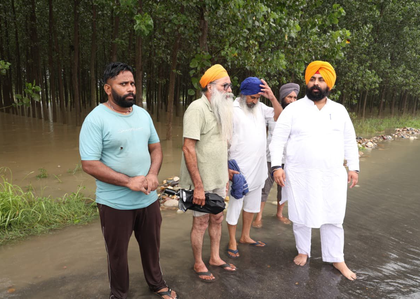Floods may drown land, but never 'Chardi Kala' spirit of Punjabis, say survivors
By IANS | Updated: September 1, 2025 15:05 IST2025-09-01T15:00:47+5:302025-09-01T15:05:12+5:30
Ferozepur/Gurdaspur, Sep 1 "We have seen tougher times earlier too and this will pass," remarked an octogenarian villager, ...

Floods may drown land, but never 'Chardi Kala' spirit of Punjabis, say survivors
Ferozepur/Gurdaspur, Sep 1 "We have seen tougher times earlier too and this will pass," remarked an octogenarian villager, whose field and farmhouse have been submerged in waist-deep water of the swollen Sutlej river, on Monday.
Octogenarian Gurdial Singh, who braved shelling from Pakistan in India-Pakistan wars of 1965 and 1971, told IANS that the spirit of 'Chardi Kala' is still alive and visible in everyone -- from elderly to young children -- despite the rainfall-induced floods that forced many villagers located only a few kilometres from the International Border in Punjab's Ferozepur district to abandon their homes.
'Chardi Kala' means the concept of high spirits in all conditions, including adversities.
With prayers on lips, his wife Nachattar Kaur remarked: "May waheguru (God) bring safety, peace and Chardi Kala to every household."
With Punjab grappling with the worst floods in 37 years and the situation devastating with all three major rivers have overflowed, putting millions of lives at risk as families have lost homes, hard earned crops and some have lost even their loved ones, Sikh volunteers, largely flood-hit villagers, are on the ground to help Central and state agencies with rescue and recovery.
Braving gushing waters, the villagers, comprising children and women, are making active participation in building and maintaining river bunds by placing soil bags, distributing medical kits and fodder by riding on boats from village to village across worst-affected districts.
"We are known globally for reaching out to assist those affected by the devastating floods and earthquakes. In this hour of crisis, we will survive owing to our high spirits," remarked another villager Gurdial Singh in Dera Baba Nanak in Gurdaspur district.
Dera Baba Nanak is a deeply sacred Sikh pilgrimage site by the Ravi river and it is named after Guru Nanak Dev, the founder of Sikhism, who spent his last years in the nearby Kartarpur, now in Pakistan.
Gurdial Singh believed when floods submerged villages their survival was the human strength.
"Instead of collapsing in despair, we cooked 'langar' (community food) in waist-deep water, rescued livestock, carried calves on our shoulders and moved families with bare essential items to safety on tractors. But in the three hours of crisis, we do regular "kirtan to keep Chardi Kala alive," he added.
Another villager Avtar Singh added, "When everything seems to be falling apart, it is our hope to survive that was floating."
Shiromani Akali Dal President Sukhbir Singh Badal, on Sunday, led an 'ardas' (prayer) at the Kartarpur Corridor entrance for flood-affected people in both Indian and Pakistani states of Punjab.
The gathering urged divine intervention to stop the rain and protect lives and livestock.
During his visit to flood-hit areas in Gurdaspur, Dera Baba Nanak and Hargobindpur, Badal distributed more than 100 trolleys of relief material.
He praised the Shiromani Gurdwara Parbandhak Committee for running community kitchens and medical camps.
Interestingly, the youth are doing more "mitti di seva" for flood relief.
"Mitti di seva" means a community effort to contribute earth to rebuild embankments.
Amid religious chants of 'Bole So Nihal, Sat Sri Akal', the farmers are voluntarily bringing earth-loaded tractor-trailers from different areas to plug the breaches.
Some farmer voluntary groups issued video appeals, asking they have enough ration, if someone wanted to contribute, they could send earth for plugging the breaches.
Flood rescue operations involving the National Disaster Response Force, the Indian Army and the district administration have been intensified.
In a swift humanitarian response, the Border Security Force has carried out an airdrop of thousands of food and ration packets in flood-affected villages of Amritsar, following the request of the civil administration.
The flooding has submerged nearly three lakh acres of farmland and hit around 1.25 lakh people in Punjab, Additional Chief Secretary-cum-Financial Commissioner Revenue Anurag Verma said after inspecting villages along the Sutlej in Ferozepur district on Sunday.
Tens of thousands of people in Punjab have been spending nights on rooftops after breaking of embankments of tributaries and overflowing of swollen rivers caused by incessant rains and release of dam waters that too damaging the newly planted paddy crop in huge tracts.
The state government has already announced a special 'girdawari' (inspection) to provide compensation for the affected crops.
Most of the worst affected districts -- Gurdaspur, Ferozepur, Amritsar, Tarn Taran and Pathankot -- are located along the India-Pakistan border.
The other districts marooned by floodwater are Hoshiarpur, Jalandhar, Kapurthala, Ropar, Anandpur Sahib and Fazilka, impacting families who have lost homes, farmers lost crops and people, largely villagers suffering greatly.
"Floods may drown the land, but never the Chardi Kala spirit of Punjabis," said Gurdial Kaur, a woman farmer from Sultanpur Lodhi in Kapurthala that is located along the Beas river, adding "in the past too Punjab has survived floods but it shows the world what resilience looks like".
Disclaimer: This post has been auto-published from an agency feed without any modifications to the text and has not been reviewed by an editor
Open in app